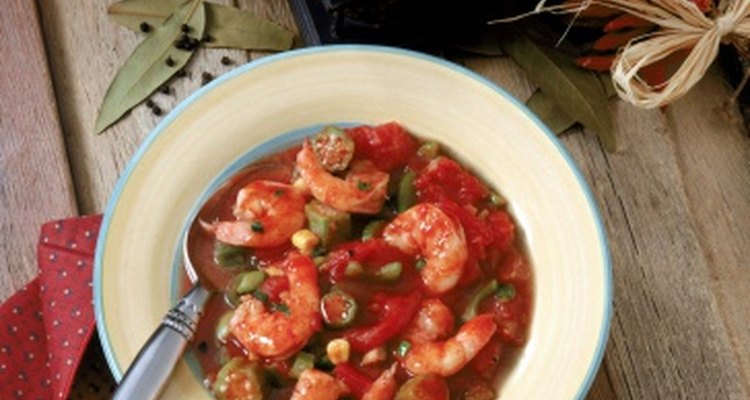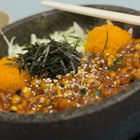
Cajun cuisine is seeped in diverse cultural influences as wide-ranging as French, Spanish, African and Nova Scotian. Two hallmarks of these cuisines are gumbo, a hearty soup, and etouffee, a stew of smothered seafood. Similar ingredients may lead you to believe they are related dishes, however etouffee is spicier and gumbo contains some elements, such as okra and file (pronounced "fee-lay") powder, that etouffee does not.
Soup Vs. Entree
Commonalities between gumbo and etouffee, such as tomatoes, a roux base, spices, onions, celery and bell peppers, may make it easy to mistake one for the other, however despite some shared ingredients, gumbo is a soup with a thinner consistency than etouffee, which is more stew-like. The latter, meaning "smother" in French, involves the smothering of seafood in a thick, tomato base which is eaten as a main dish. Crawfish etouffee and shrimp etouffee are two of the most popular variations.
Different Type of Roux
The combination of fat and flour, known as a roux, forms the basis of Cajun cooking. In gumbo, the roux is a dark, nutty brown color resulting from slow cooking. This imparts color as well as a smoky flavor to the finished gumbo – this is called a dark roux. Etouffees, on the other hand, rely on a lighter-colored roux enriched with butter – this is called a blonde roux. Roux is used as a thickener in many etouffee and gumbo recipes so that they aren’t too soupy.
Single Main Ingredient Vs. Diverse Ingredients
In etouffees, the dish generally focuses on one treatment of an ingredient, such as crawfish or shrimp. One type of seafood is the centerpiece of this entree, which is smothered in a tomato sauce. Gumbos are more free-form and have a wider latitude of mixing different ingredients, such that shrimp may also be combined with poultry and native sausages, such as Andouille. Also, okra and ground sassafras powder tend to be found in gumbo, unlike in etouffee.
Both Served With Rice
Despite their differences, and possibly another reason why the two can be confused, both gumbo and etouffee are served with rice. The rice is made separately from the dish in both cases, unlike a jambalaya, which incorporates the rice into the recipe. Either gumbo or etouffee may be ladled onto the rice.
Regional
Cajun and Creole cuisine is popular in the Southern United States, and is especially well-known in New Orleans, Louisiana.
Other Dishes
Other well-known elements in this type of cooking include andouille sausage, bay leaves, cajun seasoning or creole seasoning, green bell pepper, diced green onion, hot sauce, paprika, cayenne, file powder, and worcestershire. Popular dishes include sausage gumbo, seafood gumbo, and white rice dishes like paella with some variation of shellfish or veggies.
Related Articles

Things You Put in Gumbo

List of Cajun Food

Is Miso Soup Vegan?

Types of Portuguese Sausage

Lumpia vs. Egg Rolls

Peruvian Cooking Spices

What Type of Food Do People in Honduras ...

Difference Between Soba and Udon Noodles
What Can I Make With Cajun Pork Tasso?

A Good Substitute for Hoisin Sauce

The History of Asian Food

Types of Beef Tripe

Italian Cooking Term for Celery, ...

Vietnamese Diet

Bisto Ingredients

Classic Russian Spices

Afghan Spices

Different Types of Food in India

Korean Food Nutritional Value

History of African Peanut Soup
Writer Bio
Timothea Xi has been writing business and finance articles since 2013. She has worked as an alternative investment adviser in Miami, specializing in managed futures. Xi has also worked as a stockbroker in New York City.
Photo Credits
Jupiterimages/Comstock/Getty Images